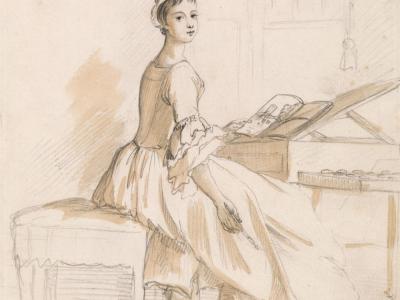
Organiser Dr Philippe Bernhard Schmid writes:
In the early modern Republic of Letters, intellectual and academic agents, go-betweens and mediators played a central role in creating and maintaining networks in local institutions of learning and global platforms of correspondence. These invisible helpers and collaborators are today largely absent from the canon of the Scottish Enlightenment. This workshop sought to understand the role of knowledge brokers in the Scottish Enlightenment broadly conceived, focusing on people, places, institutions, texts and objects for the transmission of knowledge in local or global contexts.
16–17 June 2023
Institute for Advanced Studies in the Humanities (IASH), University of Edinburgh
Co-organised by Philippe Bernhard Schmid (IASH) and Richard Oosterhoff (School of History, Classics & Archaeology). Generously supported by the Susan Manning Workshop Fund from the Institute for Advanced Studies in the Humanities (IASH), the Events Funding Scheme of the British Society for Eighteenth-Century Studies (BSECS), the School of History, Classics & Archaeology, the History of Science, Medicine and Technology Research Group (HSMT) and the Centre for Global History at the University of Edinburgh.
After opening remarks on the theory of brokerage by Philippe Bernhard Schmid (Edinburgh) and an introduction to the book culture of the Scottish Enlightenment by Thomas Ahnert (Edinburgh), the first panel of the workshop discussed the definition and scope of early modern brokerage. Vera Keller (Oregon) studied friendship albums as a helpful source to trace the many travails of brokers, following the careers of Thomas Segget of Scotland (1569–1627), Joachim Morsius of Hamburg (1593–1643) and Gottfried Hegenitius of Görlitz in Silesia (1598–?), arguing that early modern knowledge brokerage should be understood as a designated career. Anja-Silvia Goeing (Harvard) looked at the role of institutions – understood as networks of higher learning – as brokers in their own right by discussing the theoretical implications of social network theory (SNT) and actor-network theory (ANT).
The second panel addressed material approaches to the theme of brokerage. Kelsey Jackson Williams (Stirling) followed Scottish book agents and their relationship to Enlightenment Europe, Philippe Bernhard Schmid (Edinburgh) studied the reuse of letters as hybrid notebooks set in motion in Scottish networks of circulation and Matthew Daniel Eddy (Durham) discussed colonial paperwork and Britain’s global surveillance system of information collection.
The theory and practice of brokerage entails a valuable critical potential for the study of history. Networks of collaboration, the learned exchange of scientists, institutions and objects as well as the global dynamics of colonialism and the slave trade, among many other subfields, have been approached in various studies on agents, translators, secretaries, go-betweens or messengers by Simon Schaffer, Lissa Roberts, Kapil Raj, James Delbourgo, Marika Keblusek, Badeloch Vera Noldus and others. It is particularly the acknowledgement of unequal forms of exchange which is made possible through a framework of brokerage. Accordingly, the third panel discussed the role of brokers in the information networks of the British Empire and its former colonies. Franziska Hermes (Berlin) studied shipwrecked Scottish women in the late eighteenth century and their agency as female brokers in the aftermath of wrecked vessels of the British East India Company. Rosi Carr (Edinburgh) followed the life of Lachlan Macquarie (1762–1824), the Governor of New South Wales, scrutinising the relationship of settler colonialism, slavery and violent invasion. The first day of the workshop ended with the launch of Matthew Daniel Eddy’s monograph, Media & the Mind: Art, Science & Notebooks as Paper Machines, 1700–1830 (Chicago: University of Chicago Press, 2023) at the Centre for Research Collections, a hands-on exhibit of notebooks, books and manuscripts curated by the author, a reception generously sponsored by Edinburgh University Library as well as a conference dinner at The Outsider restaurant for speakers and chairs.
On the second day of the workshop, the final panel addressed local networks of circuation in Enlightenment Scotland. A little-known Scottish network of fossil exchange was presented by René Winkler (Edinburgh), who followed the exchanges of Edward Lhuyd (1660–1709), Robert Wodrow (1679–1734) and James Paterson (c.1680–1705) between Glasgow and Edinburgh. Elad Carmel (Jerusalem/Edinburgh) showed how early anti-slavery ideas were transmitted within a family of Scottish ministers from Robert Wallace (1697–1771) to George Wallace (1727–1805), eventually leading to the latter’s call for abolition of slavery in A System of the Principles of the Law of Scotland (1760). Finally, Thomas Ahnert (Edinburgh) presented a detailed and nuanced history of changes in the university curriculum in philosophy at Scottish universities in the period from ca. 1690 to 1830, revealing a development from speculative philosophy to a ‘culture of the mind’ which by the end of the century had inspired a new division of the field into the study of mind and the study of matter. These papers focused on intellectual forms of brokerage, revealing how ideas in knowledge networks were transformed through intermediaries in similar ways as material objects.
Through these diverse papers of the workshop, a picture of brokerage emerged which concentrates less on networks as larger assemblages than on the bridges in between – human, material and intellectual – which connect, disconnect and distort the flow of information in various ways, contributing to the social and material fabric of the Scottish Enlightenment and its networks.
Image in Public Domain: Paul Sandby RA, 1731–1809, British, Portrait of a Lady at a Drawing Table, undated, Graphite and brown wash on medium, slightly textured,cream laid paper, Yale Center for British Art, Paul Mellon Collection, B1975.4.717.
